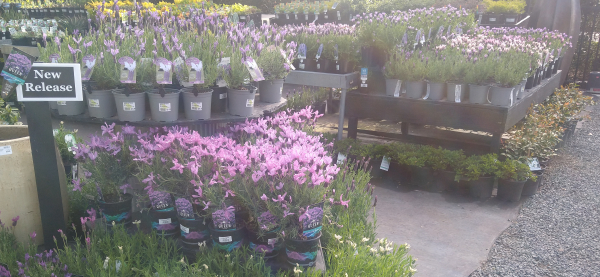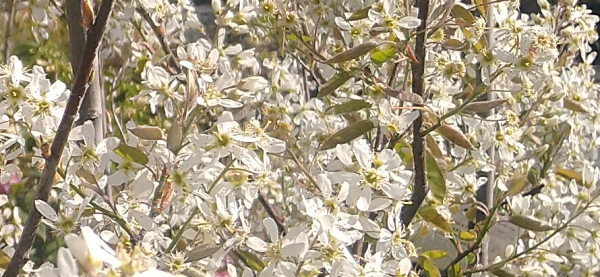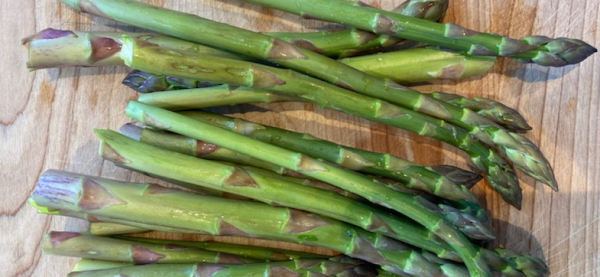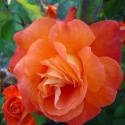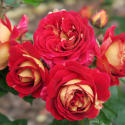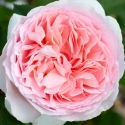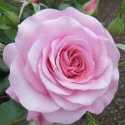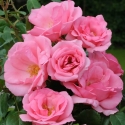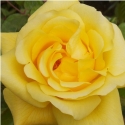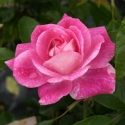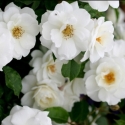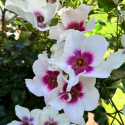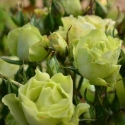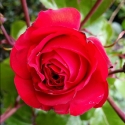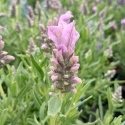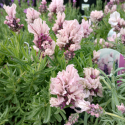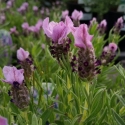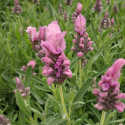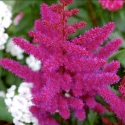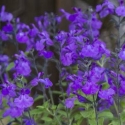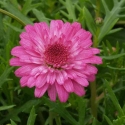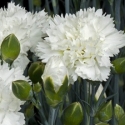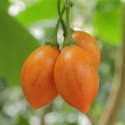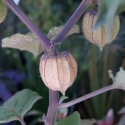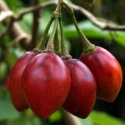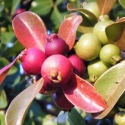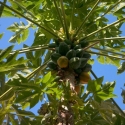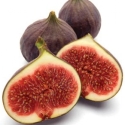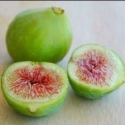Saturday 7th October, 2023
Hi
What's not to love about roses, let your imagination run wild
There are not many plants that will flower more than once and roses are pretty abundant in their ability to re-flower, some almost constantly, but with management, most modern roses, well you could probably get at least three to four flushes in a season. This makes them really suitable for a prominent place in the garden where you want colour and, of course, there are nearly always flowers to pick.
I had a chat to a customer the other day about the choice of a rose to go next to a small area of post and rail fence. There were two areas of fence being either side of the cottage. I wasn't certain how long the area was, and I believe that the two pieces of fence were of differing length. The client was pondering about a standard rose but I thought that one alone may look odd and I wasn't sure whether the space was long enough to put three. We discussed a climber, but the fence was approx 1.2 high and then I suggested that perhaps a hedge of roses would look pretty cool and be pretty easy to manage.
STANDARD ROSES MAKE FOR AWESOME ACCENT PLANTS
To recap or clarify,
standard roses are those that are grafted on an approx 80cm stem and look like a small tree or a topiary type of effect. Standardised roses usually make for great accent effect or as a design feature and there are many places to use this form of rose bush. The other big plus to planting a standard rose is the ability to underplant with other plants whether these be annuals, perennials, or something more permanent.
In my opinion three or five or odd numbers are are the best way to go, though one would use two standard roses if they are to go say, either side of a doorway or perhaps a gate. It's probably worth mentioning right here and now that the average rose bush will grow approx 1 metre square and will take around three years from a new plant to reach this mature size. This applies to the the bush on top of the standard too. Off course this make sense as a bush iceberg will grow the same size, regardless of whether it's produced as a bush or a standard.
Often standard roses will be planted along a path or along a fence or wall or often next to a house but remember the bed will need to be at least a metre wide or 1.2 would be better to accommodate the plants. How far apart to space these standards, well if they grow to a metre square over roughly three years, they will need to be slightly more than a metre apart to have a space between them. Of course, different cultivars will grow slightly larger or smaller than the said metre, but its a good average guide.
CLIMBING ROSES WILL GO PLACES
Climbing roses tend to be able to be separated into two camps, those that ramble and have quite a lax habit that allows them to grow along sideways or those that are more modern floribunda style which are more upright and stiffer a bit like a tall bush rose. Of course it's easy to generalize and as you would expect there are many other climbing roses that vary in their own unique way.
Just to add to this, some roses that you will find in the bushes, or perceived as a bush rose, could easily be trained as a small climber or particularly suit growing through and out of an obelisk. The English roses are quite good at this as many of them produce quite long canes suitable for tying down.
Graham Thomas is a great example of a bush rose but could be used as a climber along a fence or popping out of an obelisk. It would also make sense that
Graham Thomas will make for a larger bush rose in the garden and could be used as if you were going to plant a mock orange or Viburnum, but has the advantage that it will repeat flower.
These modern climbers look pretty cool if trained like an espalier with their long canes tied down along the fence rails and so then they will flower all the way along their length.
PLANT ROSES CLOSE AND CREATE A BORDER OR HEDGE EFFECT
Sometimes you need a space to be divided or in the case of the customer at the beginning, planting a row of roses meant that they would grow in together and create a hedge and pretty-up that post and rail fence. Now probably any bush rose planted at the spacing of around 70 cm to 100 cm apart will grow and form this effect. I would suggest choosing a floribunda (cluster flower) or perhaps a shrub rose. We had
Iceberg (which is a floribunda) in the display garden as a hedge or border for years that framed the main lawn and it did look pretty stunning when it was in full flower. The new rose
Ink Spots I imagine would be awesome but check out all the floribundas or just choose a rose that you like. Feel free to ask if you need more help in choice either by email or in the garden centre.
Lavish Lavenders
Funny what you notice on the way home but I was checking out the lavenders and have been quite taken with the
new lavish series. The flowers are so full compared to your normal lavenders, Like a super-duper form of the Spanish lavenders. These are stoechus ones with the rabbit ears out the top. On closer inspection, or me just being nosey and had to check it out, I discovered that the flowers were like a double flower compared to a single and there were many little flowers coming off the main flower all with their own rabbit ears creating this amazing look. It's really something quite unique I thought.
It's not only about Lavenders this time of year but there is an increasing range of perennials to add as fillers and extras in the garden and perhaps around the roses.
Astilbes are pretty cool with their plume like flowers and they can grow in the garden and also enjoy the more damp and woodland like positions.
Salvias are pretty much sun plants for the garden border or just as fillers.
Daisies constantly in flower and are good for filling gaps with colour.
Dianthus or pinks are a fav with me. Attractive foliage and those flowers with that musky typical pink fragrance. Then there is the
delphs, always stunning and fab in the picking garden or any garden. It's the time to plant all these treasures.
Tree highlight... Amelanchier Canadensis... Shad bush...
No surprise from its name that this one will be native to Canada,
Amelanchier canadensis, serviceberry or shad bush is a smallish tree, and belongs to the rose family. We have several of these planted as a small ornamental tree around the roundabout at home because it is very pretty in the spring with its mass of starry white blossoms and also for the fact that it won't grow too large. A handsome tree in the summer with attractive mid green leaves that colour nicely as we go into the Autumn. Small purplish berries follow the flowers which are edible and why I also planted one in the chook house.
A quick google also told me that this one should be more tolerant of a site that is more moist or damp as it grows naturally on wet sites of the Atlantic coastal plains.
Berries and fruits to get in for growing your own
Tamarillos The frosts are past and these are in and its a great time to get these planted so they are well developed before next year and those winter frosts. Take note that they do need to be planted in a warm sheltered spot where they are protected in the garden. There seems to be a few fancy clones out these days of these quite desirable members of the solanum family so check these out.
Tamarillo Bold Gold,
Tamarillo Lairds Large Red and
Tamarillo Tango
Cape gooseberry.. a bit of an oldie but a goodie... easy to grow all summer long and will produce masses of small golden fruit with a papery husk that are just delicious to eat on their own, add to fresh fruit salads or even make jams and the like
Guavas both
red and
yellow is a medium size bush that produces masses or red or yellow fruits that are very tasty and a tad tangy.. again eat raw or in fruits salads, make jam or just grow to feed the birds
Mountain paw paw, another one that needs a nice warm position in the garden. Quick growing round headed small tree with large, deeply lobed, evergreen leaves. Bright yellow, delicious fruit about the size of a small apple are produced, usually within 2 years if both male and female are present. Harvest in late winter, early spring when fruit is yellow and softened garden
Figs. Who doesn't love figs, makes for a handsome tree. This one fruits on new seasons wood and so if space is an issue you can cut back to a frame work each winter.
Brown turkey is a classic with large fleshy fruit purplish brown on the outside with pink flesh.. plenty of other varieties to choose from so check out Figs.
The seasons march on and these events are getting closer, so make plans now or keep an eye on our calendar.
Taranaki garden festival is open over a couple of weekends which makes it easy for a weekend getaway from Fri 27th October until Sunday 5th November
As I write this piece on fruit it reminds me that I mean to purchase a dehydrator to perhaps dry next seasons figs and even the prune plums that I grow in the orchard. I grabbed the last of my Feijoa chutney the other night and so we need to plan to make some more next fruiting season meaning I need to add a couple of
feijoas to my home fruit orchard out the back.
School holidays and we had Tony's sister and the kids to stay. Yvonne was keen to see the asparagus growing, so last night we picked and ate fresh asparagus from the garden. Also a heap of leeks that needed to be used before they go to seed, delicious in a cheese sauce with mashed potatoes and corned beef that had been in the crock pot all day. We hardly ever buy veges as there is nearly always something in the garden to harvest. Always plenty to do here in the garden like last weekend punnets to get planted.
It's been a stunning couple of days and the roses have really responded to the sunshine, lol and so have we. Hopefully the weekend will be ok to finish of the holidays. Its countdown to election day, personally will be pleased when it's all done and dusted and we all move on.
Whatever your plans have a great weekend!
Cheers from Lloyd, Tony and the Wairere team.
